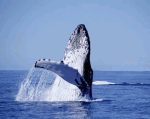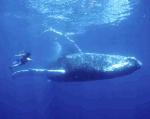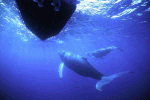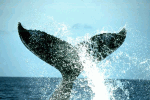by Mary L. Peachin with photography by Thomas L. Conlin, Brett Sussman and Mary L. Peachin
Nov 2003, Vol. 8 No. 2
 “Son of a breach”! I couldn’t imagine spending six days at sea just snorkeling with humpback whales. An intrepid diver for more than two decades, I’ve jet-lagged my way around the world visiting exotic underwater destinations for close encounters with sharks and sea snakes, mating cuttlefish and colorful corals. Would I be happy without a regulator, depth, or variety of creatures and reefs?
“Son of a breach”! I couldn’t imagine spending six days at sea just snorkeling with humpback whales. An intrepid diver for more than two decades, I’ve jet-lagged my way around the world visiting exotic underwater destinations for close encounters with sharks and sea snakes, mating cuttlefish and colorful corals. Would I be happy without a regulator, depth, or variety of creatures and reefs?
Serendipitously, about ten years ago, I had a humpback encounter in the Turks and Caicos. Diving at 60 feet on the first day of a dive trip, my buddy grabbed my fin stretching his arms to indicate there was something big behind us. Assuming it was a shark, I was aghast when I saw a humpback whale headed our way. With our backs to the wall, we thought our time had come. The whale checked us out before it surfaced, breached, and returned for another look. Thoughts of Jonah and being swallowed rushed through my head. The whale stopped next to us giving us a close up view of its barnacle-covered pectoral fins before swimming off without a ripple.
 Whales are loveable, and my Turks and Caicos encounter, as brief, exciting, and frightening as it was, hooked me on whales.
Whales are loveable, and my Turks and Caicos encounter, as brief, exciting, and frightening as it was, hooked me on whales.
The Silver Bank was named for the Spanish galleon, Nuestra Senora de Conception, which sank in 1641 after colliding with one of the many towering coral heads submerged inches beneath the surface of the water.
She was carrying 40 million dollars in silver bars.
It is estimated that as many as 5000 Atlantic Humpbacks migrate to the 20-mile bank of shallow water (less than 100 feet) located approximately 85-miles north of the Dominican Republic and a similar distance southeast of Grand Turk.
The scene is one of a three-month sexual orgy. Everywhere whales are breaching, finning, or lob tailing as males solicit sex from females in estrus. Bulls, their testosterone off the scale, sing musical symphonies to attract females, even to those who have just birthed and are nursing calves. Throughout their stay, each bull is single-minded and focused on one goal: finding and copulating with an agreeable female. Females without calves depart the Bank pregnant. The whales are so consumed with sex they stop feeding. Vocal cetaceans, they emanate bird-like songs mingled with mournful groans and moans combined with chirps and warbles as they perform their incredible exhibitions of courtship behavior. Of all the tones, the closest resembles that of a cow. The background noise or “drum section” is the crackling of shrimp. While many observers have witnessed whale sexual “foreplay”, curiously no one is known to have ever observed either the act of mating or birthing ritual.
Curbside at the Puerto Plata, Dominican Republic airport, we learned that the Wind Dancer, Bottom Time, and Turks and Caicos Aggressor, all scuba liveaboards had synchronized their departure date so they could transfer all of us to the dock in one bus. Our jovial guide Jorge welcomed us to his country. Between jokes he shared information about the fields of sugar cane then a drive along the malecon (boardwalk) bordering the Atlantic shoreline. We whizzed past a sculpture of Neptune on rocks about 100 yards from shore. 30-minutes later the bus stopped at the Marina Muello Viejo. After identifying our bags, we boarded our respective boats.
It was late afternoon and the Wind Dancer was not scheduled to depart until midnight for its ten-hour trip to the Bank. Having an admitted case of “March Madness”, I deserted the ship to cab to the nearest sports bar to cheer on my NCAA team. I missed the standard crew introductions, boat layout, safety procedures, rules, dinner, and just hanging out waiting for sailing time. With passengers asleep, we cruised at ten knots on a calm night; the high seas of the Atlantic are known to rock and roll.
 The next morning we awoke to find the ship tied to a mooring at the Bank, the only landmark in sight was the rusted wreck of the freighter, Polyxeni. Its hull sits on the top of the fringing reef that defines the Northeast corner of the Silver bank. The Aggressor and Bottom Time were not too far in the distance.
The next morning we awoke to find the ship tied to a mooring at the Bank, the only landmark in sight was the rusted wreck of the freighter, Polyxeni. Its hull sits on the top of the fringing reef that defines the Northeast corner of the Silver bank. The Aggressor and Bottom Time were not too far in the distance.
After breakfast, Tom gave us an introductory briefing. “It’s been a good year, we’ve had lots of whale encounters. This is my 130th week during the past 16 years.” Our first encounter will probably be a “fly-by” so all of you can get your first whale “fix.” It will be a “blow and go,” a whale surfacing and moving on. If we were downwind, Tom advised us not to breathe the mist from the “blow”. It’s smelly and oily, and not good for camera lens, “just turn around.”
Our next lesson was helping to point out the location of a whale. The bow is 12 o’clock and distance is measured by boat lengths compared to the Wave Dancer. Just tell us “2 o’clock, 3 lengths away”. Whales follow a pattern, and when they sound they leave a fluke print. “We won’t dropped you into an aggressive, rowdy group or any fins slappers. “Have good energy-don’t get pissy and moany, or so will we.” This scene is like “a Friday night happy hour at the rowdiest bar in town. By two in the morning there are only a few males left. This is the best bar in town.” There can be fourteen males competing for one female. Rowdy groups use their barnacle-covered dorsal fins to slash one another. Breachers crash in mid-air. Females mature sexually at the age of four, males mature later.
To better track the whales, Tom and Brett used stopwatches to time the calves underwater. They surface every 4-5 minutes to breathe. Most of the youngsters are like kids in their “terrible twos.” “The calves may be curious about us, but we need mom’s permission. If a whale turns direction twice, we leave them alone. We always give them their space.”
 Whale expert Captain Thomas L. Conlin has been studying whales on the Silver Bank for more than thirteen years. In 1983, he wrote the guidelines for the Dominican Republic for observing the whales and obtained the first permit (of today’s total of four) from the country. Three years later, the area was established as a whale sanctuary during the months of December until mid-April. Tom is passionate about the whales, calling them his “darlings.” He cautioned that anyone who chased or threatened a whale would be asked to get out of the water. His goal is for everyone to leave the Banks wanting to help the conservation of all whales.
Whale expert Captain Thomas L. Conlin has been studying whales on the Silver Bank for more than thirteen years. In 1983, he wrote the guidelines for the Dominican Republic for observing the whales and obtained the first permit (of today’s total of four) from the country. Three years later, the area was established as a whale sanctuary during the months of December until mid-April. Tom is passionate about the whales, calling them his “darlings.” He cautioned that anyone who chased or threatened a whale would be asked to get out of the water. His goal is for everyone to leave the Banks wanting to help the conservation of all whales.
Our first experience was on the tender Challenger captained by South African Wind Dancer Captain Brett Sussman and his mate Barcelonan David Gallardo. First on the agenda was a “check out” to learn the “seal” entry. Lying on our bellies leaning over the gunwale with mask and fins on and cameras in hand, we eased quietly into the water trying not to make a splash.
Frequently a scout (one who could climb into the boat without the ladder) was sent out to spot a whale that had just tailed down into the water. If the scout found the whale, he or she (only one woman could manage to hoist herself into the boat) raised their arm straight in the air, and all of us bailed and swam to the scout as the boat followed the scout and brought us closer to “whale side.” There was a tendency to score our scouts and even our collegiate diver occasionally flopped his fins splashing the water. And there were those of us who got so excited that we “sealed” in without our fins having to make a fast retreat to the boat because of the current.
 Our most frequent encounters were those of females and calves cuddling. Some of these encounters lasted a few minutes, the longest one was fifteen minutes. In 2000,the Wind Dancer stayed with one “sleeper” for 10-1/2 hours sharing the encounter with all the boats in the area.
Our most frequent encounters were those of females and calves cuddling. Some of these encounters lasted a few minutes, the longest one was fifteen minutes. In 2000,the Wind Dancer stayed with one “sleeper” for 10-1/2 hours sharing the encounter with all the boats in the area.
We prowled the water snorkeling from two custom-built 25-foot Privateer fiberglass tenders. The Escort and Challenger had twin four-stroke 50 horsepower engines, and were shaded with Bimini tops. Each tender was lined with benches, its bow has a splashguard to protect any dry articles. I noticed that both the Aggressor and Bottomtime searched for whales from zodiacs without shade or the higher vantage view.
Whenever we sited a mother with calf, occasionally accompanied by a courting escort, we “sealed” quietly into the water, hoping the whales would become curious and swim toward us. We were told to swim with our hips to the side barely moving our fins. After a few encounters we sensed how to give the whales their “space” and not make them feel corralled. Each tender also had a divemaster/photographer who directed us in the water when not passing us bottled water, fresh fruit, sandwiches, or candy and cookies.
The Wave Dancer has never have had an whale accident, but an encounter can change in a minute if another whale shows up. Dive fins are a necessity for the current and the possibility of avoiding the danger of a tail slap. Several of us missed being hit with a tail by a only a few yards.
At 8:30 each morning we boarded the tenders taking a break between 12-2 before we headed out again for three hours each afternoon. Every day our group of nine changed boats so we were alternatively captained by Wave Dancer Captain Brett Sussman or whale expert Tom Conlin and their mates. We all assumed responsibility for scanning the area looking for obliging, slow moving whales, ones that would provide the best “soft-in-water” close up encounters rather than fly-bys.
 Even when “whale waiting” seemed slow, there was exciting surface activity to watch. Close and in the distance whales breached or a rowdy group, their dorsal fins bloodied from fighting to become the alpha male might pass near the tender chasing a female and calf away from us. Several times Tom dropped hydrophones into the water so we could heard the range of the whale’s song.
Even when “whale waiting” seemed slow, there was exciting surface activity to watch. Close and in the distance whales breached or a rowdy group, their dorsal fins bloodied from fighting to become the alpha male might pass near the tender chasing a female and calf away from us. Several times Tom dropped hydrophones into the water so we could heard the range of the whale’s song.
One morning the group on the Explorer had a morning filled with a dozen whale encounters plus a “soft-in-water” with a school of half a dozen offshore spotted dolphins, many with 2-foot newborns. The group included seven southerners that privately jetted into Puerto Plata and pretty much hung together, a computer geek, and a single from Italy. So excited to be in the water with dolphins one of them said, “it went way beyond the script.” The nine of us in the Challenger, which included seven Americans and a couple from Scotland, were satisfied with four immature rowdies, which for some unknown reason sometimes includes females, giving us a close up view of their bloody dorsal fins by swimming under our boat.
Then we found a mom and calf being followed by an escort, a young male hoping to court her. “Sealing” into the water, we watched as they circled us rising to the surface. Females nurse by releasing milk into water. Calves are whitish grey at birth. It was one of our best encounters. Two more fly-bys and it was time to break for lunch.
 Another day, we were on the lucky tender. After following a mother and a calf for awhile she turned radically twice, so Brett steered away. That was a signal the whale wasn’t interested in us. Finding another female, we spent close to three hours with her. The first of numerous encounters was probably the most exciting as the calf played and nuzzled with its mother at a depth of about 30 feet. After 15 minutes, Brett noted the third time the baby surfaced for air, we wore out our welcome. The calf breached missing us by a few feet. Then mom tail breached slapping the water to tell us “enough.” Divemaster Hoi Leung shouted for us to head for the boat and get out of the water. When the whales “settled” we again entered the water with them, this time the baby was nursing and snuggling quietly. Brett called Tom so his snorkelers could share this spectacular experience. We took turns watching as they enjoy the same encounter. The next time we entered the water the baby was upright as if standing on her tail.
Another day, we were on the lucky tender. After following a mother and a calf for awhile she turned radically twice, so Brett steered away. That was a signal the whale wasn’t interested in us. Finding another female, we spent close to three hours with her. The first of numerous encounters was probably the most exciting as the calf played and nuzzled with its mother at a depth of about 30 feet. After 15 minutes, Brett noted the third time the baby surfaced for air, we wore out our welcome. The calf breached missing us by a few feet. Then mom tail breached slapping the water to tell us “enough.” Divemaster Hoi Leung shouted for us to head for the boat and get out of the water. When the whales “settled” we again entered the water with them, this time the baby was nursing and snuggling quietly. Brett called Tom so his snorkelers could share this spectacular experience. We took turns watching as they enjoy the same encounter. The next time we entered the water the baby was upright as if standing on her tail.
A few hundred yards from the Wind Dancer, we found another female and calf “settled” in the water. The depth was close to a hundred feet so our best view was initially of the white pectoral fins and watching the calf coming to the surface to breathe. She would nuzzle her mom then frolic before surfacing to flap her pectoral fins before rejoining her mother. Every third or fourth time, the mother would surface with the calf and move off. Throughout the morning both tenders took turns observing this routine until mom tired of us and moved off. That afternoon we found a mom and calf with two escorts. The calf was a female (only observed by anatomical viewing of its hemispherical lobe), we were unable to determine the sex of the escorts. It was assumed that one or both were males.
The 120-foot M/V Wind Dancer has a 28-foot beam that displaces more than 300 tons of water for added stability. She has eight staterooms (sleeps 18) on the lower deck, each with a double lower bed and twin upper and a small private bathroom with shower. There is an owner’s suite on the salon deck with a queen bed, glassed-in shower and a real window. Each room varies marginally in size, our small cabin didn’t have enough room for us to pass one another. To reach the upper bunk with my short legs, I had to stack three pillows on my roommate’s bed. On most liveaboard boats, I either roast or freeze to death, but our little cabin, without it’s own temperature control, was comfortable. The room also had a mirrored cabinet with sink, a closet with three drawers, a black-painted porthole with drape, a hairdryer, bath amenities, and those signatures of Peter Hughes: blue terry robes and morning coffee delivery. There was probably a crew of ten and each of them were helpful and enthusiastic.
 While most of the guests were divers, the boat does not require C-cards. It helps to be comfortable in the open sea, a good swimmer, and reasonably physically fit. Six and a half-hours of continual (on a good day) sliding out of the boat tenders, swimming quietly but quickly a 100 yards, then climbing up the ladder after many whale encounters can be exhausting.
While most of the guests were divers, the boat does not require C-cards. It helps to be comfortable in the open sea, a good swimmer, and reasonably physically fit. Six and a half-hours of continual (on a good day) sliding out of the boat tenders, swimming quietly but quickly a 100 yards, then climbing up the ladder after many whale encounters can be exhausting.
Breakfast was a choice of a continental buffet or made to order breakfast, or both. Lunch was a non-descript buffet. Dinner included soup (never served hot), an iceberg lettuce salad, a choice of two entrees, and dessert. While no one appeared unhappy with the food, I found it unimaginative and mediocre. One passenger was allergic to wheat and his dietary needs were accommodated. Tired snorkelers enjoyed nightly turndown service with chocolate kisses on their pillow. The trip included an evening complimentary “well” self-service bar cocktail hour with nuts and occasionally fried appetizers. One lunch and one dinner was a topside barbecue.
The lounge and dining room is comfortable and has an entertainment center with a CD, VCR, Hi-8mm player, and library. A real highlight of the trip were Tom’s almost nightly whale lectures and his wonderful photographs.
While the Hughes boat have historically set a higher standard for liveaboards, the Wind Dancer, which alternates between the Bahamas and Turks & Caicos, was headed into dry-dock several weeks after our trip. The ship was showing some wear and tear especially the rusted paint.
 Like any day of diving, there are days when you see lots of stuff, when the current is strong, or the visibility too poor. The same is true with snorkeling with Silver Bank humpbacks. On our last day, we had about half a dozen quick fly bys in the morning and only a few in the afternoon. Overall, we had a good week of encounters, calm waters, but cloudy skies and poor visibility. At some locations we snorkeled with schools of thimble jellyfish, fortunately none were in the stinging mode. Before heading back to the ship to return to Puerto Plata, we stopped to snorkel the wreck of the Polyxeni. What a different experience after viewing magnificent whales. Instead we were gazing down at nudibranches, tangs, and a couple of parrotfish. As Tom would say, “Oh whale”!
Like any day of diving, there are days when you see lots of stuff, when the current is strong, or the visibility too poor. The same is true with snorkeling with Silver Bank humpbacks. On our last day, we had about half a dozen quick fly bys in the morning and only a few in the afternoon. Overall, we had a good week of encounters, calm waters, but cloudy skies and poor visibility. At some locations we snorkeled with schools of thimble jellyfish, fortunately none were in the stinging mode. Before heading back to the ship to return to Puerto Plata, we stopped to snorkel the wreck of the Polyxeni. What a different experience after viewing magnificent whales. Instead we were gazing down at nudibranches, tangs, and a couple of parrotfish. As Tom would say, “Oh whale”!
I couldn’t have felt more enthusiastic about spending four and a half days in the water with the whales, but the thought of having to spend two nights in Miami, both on the outgoing and return flight home, bummed me out. American Airlines operates only one flight daily to Puerto Plata at a time that doesn’t allow connections, especially those who live on the west coast. I welcomed not having to haul much more than fins, mask and snorkel, a couple of skins, and only a few clothes. I abandoned the heavy camera gear and film, and traveled light with a new digital camera and Ikelite case. I didn’t relish the thought of having to bunk with a roommate on a sold out ship, and dreaded the thought of getting stuck sleeping in the upper, smaller bunk.
Aquatic Adventures doesn’t advertise, the trips are sold out years in advance. Tom will tell you “it’s not Sea World or Shamu.” We joined a group of less than 10,000 people (maybe 20,000 in the world) who have ever been in the water with humpback whales.”
On Thursday, our final day of snorkeling, Tom gave us the choice of returning to Puerto Plata during the nighttime or traveling during the day on Friday. Asking each of us privately, the group unanimously decided to depart that night. This allow some of us to travel standby and get home a day earlier even with a half day tour of Puerto Plata. Those who had made plans to continue their stay in the Caribbean extending to another destination remained on the boat. Frankly, I would have preferred another day of snorkeling with the whales, but that wasn’t an option.
If you go:
These trips, all offered between mid-February through mid-April sell out months in advance. American Airlines provides service to the Dominican Republic from their gateways in Dallas and Miami.
Whale expert Tom Conlin of Aquatic Adventures charters Peter Hughes’ Wind Dancer. Conlin’s company can be reached at 1-954-382-0024 or www.aquaticadventures.com.
You can also book through Marc Bernardi’s Aquatic Encounters, 800-757-1365 pin #1815 or www.aquaticencounters.com, or directly with Peter Hughes 800-932-6237 or www.Peterhughes.com.
The Wind Dancer runs $2295 plus a $150 Sanctuary fee.
The 120-foot Turks & Caicos Aggressor II offers trips during the same time period. Aggressor Fleet, 800-348-2628 or www.aggressor.com/tca_home.html (direct link to page). The T&CII uses zodiacs to search for whales. $2295 includes sanctuary fee.
Bottom Time, the third boat licensed in the sanctuary can be reached at 800-234-8464, www.bottomtimeadventures.com Cost is $2095 (this bare bottom price does not include alcohol, airport transfers, park fee, or tourist card or country exit fee. They also uses zodiacs.
